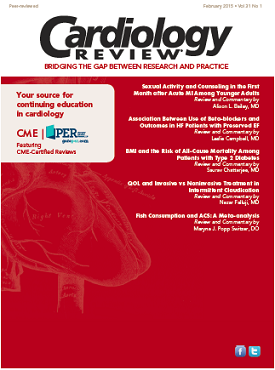Publication
Article
Cardiology Review® Online
Association Between Use of Beta-blockers and Outcomes in HF Patients with Preserved EF
Author(s):
It is well established that among patients with the clinical syndrome of heart failure, approximately half have preserved systolic function, known commonly as heart failure with preserved ejection fraction (HFpEF). Although originally considered to be a syndrome that pathophysiologically involves diastolic dysfunction, ongoing investigation suggests that although diastolic abnormalities may be present in many patients, other aspects of pathophysiology likely also contribute to symptoms. This study examined the association of beta-blockers with mortality in patients with HFpEF.

Leslie Campbell, MD
Review
Lund L, Benson L, Dahlstrom U, Edner M, Friberg L. Association between use of ß-blockers and outcomes in patients with heart failure and preserved ejection fraction. JAMA. 2014;312:2008-2018.

It is well established that among patients with the clinical syndrome of heart failure, approximately half have preserved systolic function, known commonly as heart failure with preserved ejection fraction (HFpEF). Although originally considered to be a syndrome that pathophysiologically involves diastolic dysfunction, ongoing investigation suggests that although diastolic abnormalities may be present in many patients, other aspects of pathophysiology likely also contribute to symptoms.1
Study Details
Lund and his coauthors2 set out to study the association of beta-blockers with mortality in patients with HFpEF. The study was performed with data from the Swedish Heart Failure Registry, for which inclusion criteria were clinician-judged heart failure.Among heart failure patients, those with HFpEF were defined as those with EF>40%.The HFpEF group was divided into beta-blocker-treated patients (N = 5496) and untreated patients (N = 2748) in a 2:1 ratio. There was also a control group of heart failure patients with reduced ejection fraction (HFrEF), defined as patients with an EF≤39%. The HFrEF group was also matched at a 2:1 ratio between those treated with beta-blockers (N = 4054) and those who were untreated (N = 2027). This group served as a positive-control analysis to confirm that the results in the Swedish Registry were representative of those in other randomly controlled trials that have established beta-blockers as a treatment that reduces mortality.
Beta-blocker treatment was defined as beta-blocker prescription at discharge from the hospital or during an outpatient visit, either with or without consideration of crossover. Beta-blocker use was analyzed by a dispensed-drug registry in Sweden in which all pharmacies are required to participate by law.
A majority of patients in all groups were also treated with renin-angiotensin system (RAS) antagonists (approximately 70%) and diuretics (approximately 80%). Other medications included aldosterone antagonists (approximately 25%) and digoxin (approximately 15%).
The primary outcome was all-cause mortality. Mortality data were obtained from the Death Registry of the Swedish Board of Health and Welfare. A secondary outcome was all-cause mortality or hospitalization for heart failure.
Comparative data regarding comorbidities were obtained from the heart failure registry’s ICD-10 codes. The cohorts were well matched. Among the HFpEF group, comorbid hypertension (approximately 57%) and atrial fibrillation (approximately 53%) were common. Musculoskeletal or connective tissue disorder was present in 34% of patients. This was more prevalent than prior myocardial infarction (approximately 30%) and diabetes mellitus (approximately 25%).
The primary endpoint was met with lower all-cause mortality but the secondary endpoint that included lower hospitalization rates for heart failure was not.
The survival curve between those treated with beta-blockers and those who were not treated with beta-blockers separates early (approximately one-quarterof the way through the year) and continues a gradual separation during the 5-year follow up. Curves for survival free from heart failure rehospitalization do separate in favor of beta-blocker treatment after approximately 1 year but were not statistically significant.
COMMENTARY
A well-designed study that calls for a prospective follow-up trial
The study was well organized and the groups were well matched.
As a registry study, there was no means to verify the diagnosis of heart failure or exclude other rare comorbidities (eg, amyloidosis, renal artery stenosis, hypertrophic cardiomyopathy, or pulmonary arterial hypertension).
The authors correctly point out their study’s limitations with respect to selection bias and confounding inherent to observational studies. Using propensity scores from 52 variables was a good effort to reduce this limitation. Clinical explanations for use or nonuse of beta-blockers were not available (eg, hypotension or intolerance). In addition, case-specific mortality was unknown.
The mortality difference among patients who received beta-blockers was 36% versus 46% death in those who did not. The same difference was not seen in the 2:1 propensity-matched group. The secondary endpoint of mortality and rehospitalization was not demonstrated.
Mortality reduction was 7% in the HFpEF group, lower than the 35% mortality reduction in a prior meta-analysis of randomized controlled trials of patients with HFrEF, but still relevant.3
The ACC/AHA Guidelines4 address treatment of stage C HFpEF with only 2 Class I recommendations: (1) systolic and diastolic blood pressure should be controlled in patients with HFpEF in accordance with published clinical practice guidelines and (2) diuretics should be used for relief of symptoms due to volume overload in patients with HFpEF. Class IIa recommendations include (1) coronary revascularization in patients with coronary artery disease in whom symptoms (angina) or demonstrable myocardial ischemia is judged to be having an adverse effect on symptomatic HFpEF despite guideline determined medical therapy and (2) management of atrial fibrillation according to published clinical practice guidelines in patients with HFpEF is reasonable to improve symptomatic HF, and (3) the use of beta-blocking agents, angiotensin converting enzyme (ACE) inhibitors, and angiotensin II receptor blockers (ARBs) in patients with hypertension is reasonable to control blood pressure in patients with HFpEF.
Of great interest are possible differences in risk factors and underlying disease states in patients with HFpEF compared with those with HF with reduced EF (HFrEF). The Framingham Study investigators examined clinical characteristics and risk factors at the time of HF onset as well as long-term survival in patients according to preserved versus reduced EF.5Predictors of HFpEF included increased systolic blood pressure, atrial fibrillation, and female gender, whereas HFrEF was associated with prior myocardial infarction and left bundle-branch block QRS morphology.In this community-based population, long-term prognosis was equally poor in both HF types, as well as in men and women, with a median survival of 2.1 years.
Last year Quiroz, et al6 described some prevalence and characteristic differences between HFpEF and HFrEF and found HFpEF patients older, overweight, female gender, hypertensive, and hyperlipidemic. Blood pressure and creatinine were higher and B-type natriuretic protein (BNP) was lower. Thirty-day readmission rate was lower in HFpEF patients but 30-day all-cause mortality after the index hospitalization and 1-year survival curve was no different between the 2 types of heart failure.
The I-PRESERVE trial database also provided a large amount of data from which to examine predictors of adverse outcomes in patients with HFpEF. Komajda and coauthors7 reported that log N-terminal pro—B-type natriuretic peptide (NT-proBNP) age, diabetes mellitus, and previous hospitalization for HF were the most powerful factors associated with the I-PRESERVE primary outcome (all-cause mortality or cardiovascular hospitalizations) and with the HF composite end point (HF death or hospitalization). NT-proBNP, age, diabetes mellitus, and left ventricular ejection fraction were the strongest independent predictors of all-cause mortality.
Investigators from the I-PRESERVE trial also reported that obesity is common in HFpEF patients, and that there was a U-shaped relationship with adverse outcomes, with the greatest rate of adverse outcomes in the lowest and highest body mass index categories.8 Obesity was not considered in the study byLund et al.
Specific medication therapies have been studied in HFpEF. TOPCAT9 was a large randomized, double-blind, placebo-controlled study that sought to determine whether mineralocorticoid receptor antagonists (eg, spironolactone) could produce clinical benefit in HFpEF. The researchers did not find a significant difference in the primary endpoint, which was cardiovascular death, HF hospitalization, or aborted cardiac arrest. There was a reduction in hospitalization for heart failure.
A meta-analysis of beta-blockers in HFpEF, previously published by Bavishi et al,10 included 15 observational studies and 2 randomized control trials (RCTs) involving a total of 27,099 patients. The observational studies did associate beta-blocker therapy with lower all-cause mortality. This was not demonstrated in the RCT, though; the RCT was not powered and had a high loss to follow up.
To date, evidence-based therapies for HFpEF are shallow in numbercompared with the evidence for therapies in HFrEF. Although there may be some common risk factors for these syndromes, there are also important differences in risk predictors. This implies that different treatment strategies may be needed.
Attention should be given to overall survival rates, which ranged between 40% and 55% at 5 years after entry into this study’s registry, regardless of treatment.2 Iwould point out again that the Framingham investigators report median survival of 2.1 years after diagnosis of heart failure. Given the outcomes and lack of data to help guide our treatment for half of patients with heart failure, more work is needed. The authors have provided a well-designed registry analysis with findings that should raise further interest in beta-blockers for the treatment of HFpEF. I look forward to a prospective randomized trial.
References
1. Udelson JE. Heart failure with preserved ejection fraction.Circulation. 2011;124:e540-e543doi: 10.1161/CIRCULATIONAHA.111.071696.
Lund L, Benson L, Dahlstrom U, Edner M, Friberg L. Association between use of ß-blockers and outcomes in patients with heart failure and preserved ejection fraction. JAMA. 2014;312:2008-2018.
2. Brophy, JM, Joseph L, Rouleau JL. Beta-blockers in congestive heart failure: a Bayesian meta-analysis. Ann Intern Med. 2001;134:550-560.
3. Yancy CW, Jessup M, Bozkurt B, Butler J,et al. 2013 ACCF/AHA Guideline for the Management of Heart Failure. A Report of the American College of Cardiology Foundation/American Heart Association Task Force on Practice Guidelines. J Am Coll Cardiol. 2013;62(16):1495-1539.
4. Lee DS, Gona P, Vasan RS, et al. Relation of disease pathogenesis and risk factors to heart failure with preserved or reduced ejection fraction: insights from the Framingham Heart Study of the National Heart, Lung, and Blood Institute. Circulation. 2009;119:3070—3077.
5. Quiroz, R, Coros G, Shaw P, Liang CS, Gautherier DF, Sam F. Comparison of characteristics and outcomes of patients with heart failure preserved ejection fraction versus reduced left ventricular ejection fraction in an urban cohort. Am J Cardiol. 2014. Feb 15;113(4):691-696.
6. Komajda M, Carson PE, Hetzel S, et al. Factors associated with outcome in heart failure with preserved ejection fraction: findings from the Irbesartan in Heart Failure With Preserved Ejection Fraction Study (I-PRESERVE). Circ Heart Fail. 2011;4:27—35.
7. Haass M, Kitzman DW, Anand IS, et al. Body mass index and adverse cardiovascular outcomes in heart failure patients with preserved ejection fraction: results from the Irbesartan in Heart Failure With Preserved Ejection Fraction (I-PRESERVE) Trial. Circ Heart Fail. 2011;4:324—331.
8. Pitt B, Pfeffer MA, Assmann F, et al. Spironolactone for heart failure with preserved ejection fraction. NEngl JMed. 2014; 370:1383-1392.
9. Bavishi C, Chatterjee S, Ather S, Patel D, Messerli FH. Beta-blockers in heart failure with preserved ejection fraction: a meta-analysis. Heart Fail Rev. 2014. Jul 18. [Epub ahead of print]
About the Author
Leslie Campbell, MD, is Medical Director of Advanced Heart Failure and Transplant at the Barry S. Levin, MD, Department of Transplantation at California Pacific Medical Center in San Francisco, CA.






